Mountain of God: Where was the real Mount Sinai, and the Location of the Ark of the Covenant?
In the late twelfth century, crusader knights of the Templar order, from the county of Warwickshire in central England, were rumored to have found the Ark of the Covenant while stationed at the ancient city of Petra in southern Jordan. Regardless of whether or not they really did find this sacred artifact, my research suggests that they were in the right place to have found it.
The Bible tells us that the Ark of the Covenant was the Ancient Israelites’ holiest relic. A golden chest made to hold the tablets inscribed with the Ten Commandments, it was kept in the Temple of Solomon in Jerusalem until the city was sacked by the Babylonians in 597 BC. According to the Old Testament’s Second Book of Maccabees (still in the Roman Catholic Bible but removed from the King James version), the prophet Jeremiah ordered it to be hidden before Jerusalem fell. In chapter 2, verses 4 and 5 we are told:
[Jeremiah] ordered that the tent and the ark should follow with him, and that he went out to the mountain where Moses had gone up and had seen the inheritance of God. Jeremiah came and found a cave-dwelling, and he brought there the tent and the ark and the altar of incense; then he sealed up the entrance.
The account goes on to say that the Ark was never recovered. Indeed, it remains lost to this day.
Searching through the Sinai Wilderness
It might seem that the place where Jeremiah is said to have hidden the Ark would be relatively easy to locate. Not so. In the biblical narrative, the mountain where Moses saw “the inheritance of God” could apply to Mount Nebo, where Moses saw the Promised Land, or Mount Sinai, where he saw God himself and received the Ten Commandments. However, as Mount Sinai is where the Ark was originally made, it seems the more likely of the two. The big problem is that the whereabouts of Mount Sinai seems to have been forgotten, and later wrongly located. The site considered to be Mount Sinai by today’s Church is the mountain of Jebel Musa in eastern Egypt, but this tradition only developed in early Christian times and there is no archeological or biblical evidence to support it. In fact, the local geography fails to match Old Testament descriptions of the place it refers to as Mount Sinai. Consequently, biblical scholars have long debated the sacred mountain’s true location.
Although Mount Sinai is the best-known name for the site, the Old Testament actually refers to it by two other names: Horeb and the Mountain of God. Said to be where God revealed himself and his laws to mankind, it is depicted as the most hallowed site on Earth.
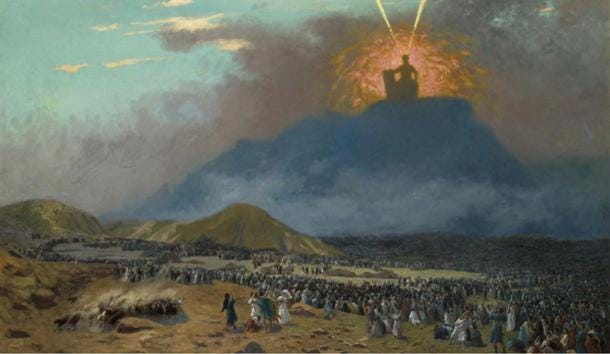
But strangely, although we are told that the sacred mountain was somewhere in the Sinai Wilderness— an area which includes eastern Egypt, together with southern Israel and Jordan— the Bible does not directly reveal its whereabouts. There are hundreds of mountains in the Sinai Wilderness, an area of over fifty thousand square miles of largely inhospitable country, so which one was Mount Sinai? If we examine the Old Testament, we find that it does provide important clues to lead to its location, but they are dispersed throughout different passages. For example, the book of Exodus, chapter 2, verse 1, refers to Moses’ first visit to Mount Sinai while he was living as a nomadic shepherd, having been exiled from Egypt by the pharaoh.
Now Moses kept the flock of Jethro his father-in-law, the priest of Midian: and he led the flock to the backside of the desert, and came to the mountain of God, even to Horeb.
The author places the Mountain of God in the "backside of the desert" with regards to Midian. Midian was at the extreme south of the Sinai Wilderness, the desert in question, and so the mountain would seem to be on its northern side, an area now called the Shara Mountains.
It is here that Moses is later said to have performed a miracle. According to the Old Testament book of Numbers, chapter 20, verses 11-14, after he has returned to Egypt and led the Israelites to freedom in the Sinai Wilderness, Moses takes them to a place called Meribah, on the border of the kingdom of Edom. Here, he creates a miraculous spring by striking his staff against a rock. The very same story of the miracle at Meribah is also told in the book of Exodus, chapter 17, verses 5-7, but in this passage we are additionally told that the incident occurs at Horeb – the Mountain of God. So, taken together, these two passages show that the ancient scribes believed that Mount Sinai rose above a place then called Meribah on Edom’s border.
The valley in which the kingdom of Edom stood during Moses’ time, around 1300 BC, later became the site of the city of Petra in Roman times, and the only way into this once fertile valley, avoiding a gruelling haul over the mountains, was through a narrow rocky gorge known as the Siq (Arabic for canyon). As we are told that, after he created the miraculous stream, Moses sent a messenger to the king of Edom to ask permission to enter his land (Numbers 20: 14 – 17), the account must have located the event at the entrance to the Siq.

Astonishingly, although biblical scholars seem to have completely overlooked these giveaway clues to pinpoint the Mountain of God, the local people certainly haven’t. At the entrance to the Siq there is a Bedouin shine built over a sacred pool called Ain Musa – the Spring of Moses – said to be the very place where the miracle occurred. Rising above Ain Musa is a mountain today called Jebel al-Madhbah, so was this the sacred site the Old Testament authors referred to as Mount Sinai, Horeb, and The Mountain of God?

The Valley of Moses
Remarkably, even the name of the valley in which Petra is situated has long been associated with Moses by the local people. It is called Wadi Musa, meaning the Valley of Moses. The ruins of many ancient tombs line the cliffs of Wadi Musa, dating from the Roman period around two thousand years ago, but on top of Jebel al-Madhbah there are the remains of a much older religious complex. Possibly dating from as early as the period in which the story of Moses is set, it consists of an open air temple at the summit, and two twenty-foot-high obelisks either side of a flat, stone terrace cut from the mountainside below it. Here, archaeologists have discovered pieces slate originally used to pave the area that were once polished to create a shiny blue surface.
The local Bedouin still regard this concourse as hallowed ground, and call the obelisks “the feet of God.” It certainly matches the description of Mount Sinai in the Old Testament. According to Exodus, chapter 19, verse 17:
And Moses brought forth the people out of the camp to meet with God; and they stood at the nether part of the mount.
“Nether” means “lower,” so the Israelites were said to be on some lower precinct to the sacred mountain top where Moses ultimately went alone to commune with God. If Jebel al-Madhbah was the Mountain of God, then the “nether part” could have been the paved terrace with its obelisks. It is further described in Exodus, chapter 24, verse 10:
And they saw the God of Israel: and there was under his feet as it were a paved work of a sapphire stone.
Surely the Jebel al-Madhbah concourse, known as Obelisk Terrace, has to be the “nether part of the mount” referred to in the biblical narrative. Archaeologists have determined that it had once been paved with polished blue slate that may well have glimmered like sapphire in the sunlight, and the Bedouin tradition calls the obelisks the feet of God; the biblical account specifically refers to God’s feet.
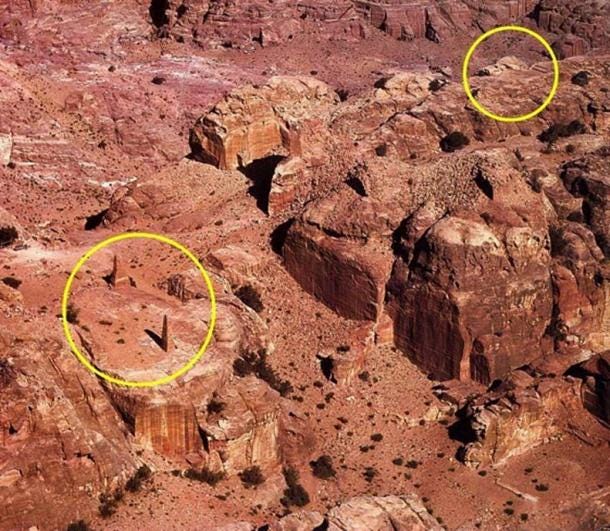
If Jebel al-Madhbah, rising high above the ancient city of Petra, was the biblical Mountain of God, then it might have been in one of its many caves that Jeremiah hid the Ark of the Covenant – precisely where the Templars are said to have found it many centuries later.
A fuller account of this investigation can be found on Graham Phillips’ website: grahamphillips.net
And in his book The Templars and the Ark of the Covenant.
Top Image: Mount Sinai, or Mount Moses. Source: CC BY-SA 3.0


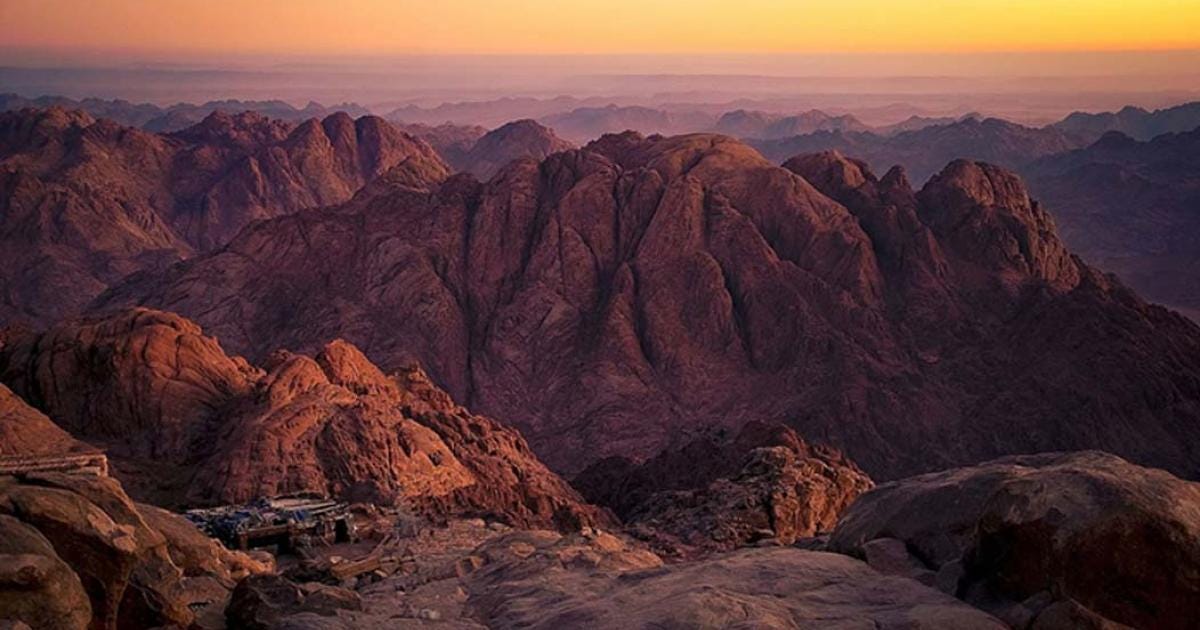
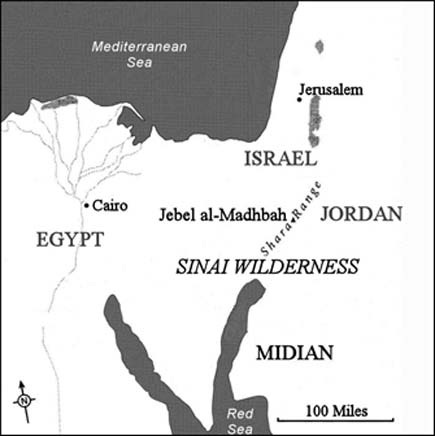
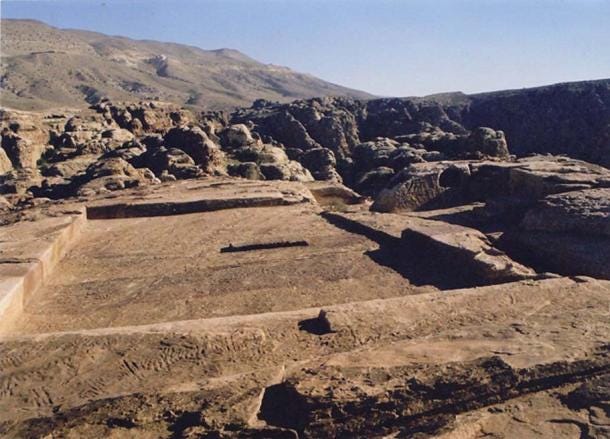

Congratulations on your work, we humanity need more scholars like yourself who spent countless hours of your (life) time working to find truth. Thank you again, will the almighty keep blessing all your proyects!!
I saw a bunch of posts over the past few days talking about a remote viewer from the CIA located the Ark during a remote viewing session. Says he was only given map coordinates and when he went to the location (in his mind) he described the Ark and what the location looked like. Lots of people think it’s Dome of the Rock. I’m very curious about this because years ago an archeologist was investigating the area under the Dome of the Rock and saw something shimmering in the darkness when he had gotten pretty far into the area. His work was stopped suddenly by the government so there was no more information.
I read/looked at the CIA documents (declassified in 2000) and it sounds like someone saw something. I didn’t think much of remote viewing until I read about a fairly well known psychic named Ingo Swan. I also met someone who had been part of one of the government experiments. There are lots of things we don’t understand so… who knows.
To the author of this article; your work is amazing. I learned a lot reading this. Thank you